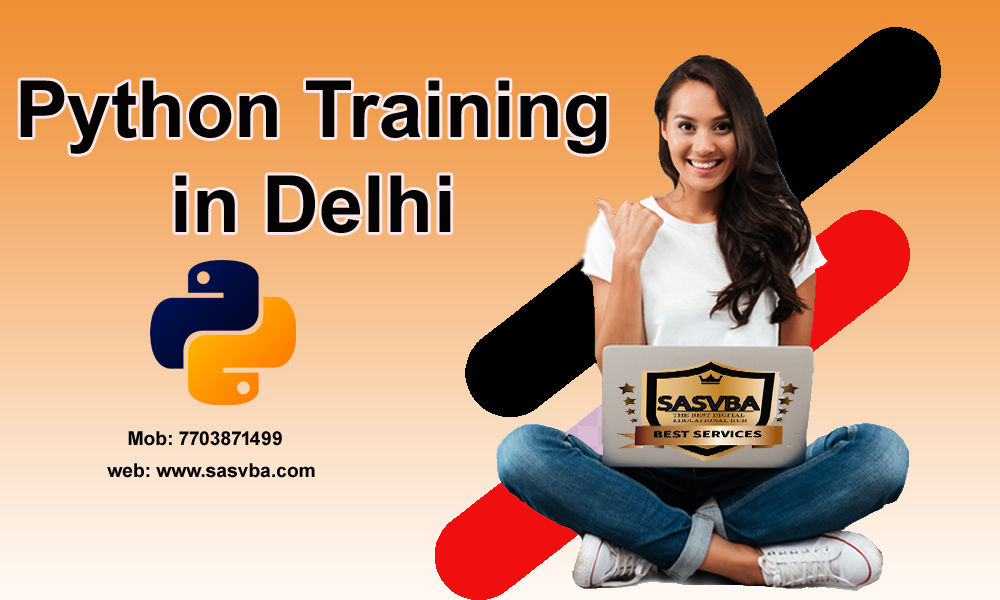Best Online Python Training in Delhi | Python Jobs in Delhi for freshers 2022
|
10 Reasons to
Enroll in a Python Course at SASVBA Institute in Delhi |
|
|
1 |
The most up-to-date and advanced Python course
available. |
|
2 |
With a Guaranteed Internship, we can help you
find a job. |
|
3 |
Personal trainer with ten years of expertise in
the field. |
|
4 |
Complete Interview Preparation for Live Projects. |
|
5 |
Customize your timing preferences based on your
need. |
|
6 |
Free Spoken English Training and Personality
Development Classes. |
|
7 |
Trainers provide one-on-one help. |
|
8 |
Study materials, video sessions, interview
questions, and much more are all available for free. |
|
9 |
Certificate that is recognized around the world. |
|
10 |
There are EMI options available. |
|
11 |
There are no limits to how many backup classes
you can have. |
Are
you looking for the best institute for Python training in Delhi SASVBA that
offers Python classes along with live projects by an expert instructor. Our
Python training program in Delhi is specially designed for Undergraduates,
Graduates, Working Professionals and Freelancers. We provide end-to-end
learning on the Python domain with deep dives to build a winning career for
every profile.
What is Python?
Python is a widely used programming language that focuses on code readability to help programmers write logical and straightforward code for a variety of tasks. It is progressive constructed, suggesting that it applies programming practices during runtime rather than during aggregation, as static programming languages do.
It was initially released in 1991 after being developed in the late 1980s. In the year 2000, Python 2.0 was released, bringing with it new features like as list appreciations. Python interpreters are available for a variety of operating systems. Python's large standard library is generally mentioned as one of the language's strongest points. It provides designers with the tools they'll need to complete a project.
Because a large portion of the standard library contains cross-platform Python code, programmers just need to adapt or modify a few modules for different executions. The Python Package Index, which is the authoritative archive for third-party Python software, has over 200,000 packages.
Another reason for its popularity is that it is possibly the most extensive language available. Python is a simple-to-learn programming language that is widely used due to its well-organized structure. The code is written in English, which makes it very easy to understand. In this way, the creative cycle appears to be very natural.
Features of Python Programming
The following are some of the properties of Python programming that make it a popular language: • Python has a large number of data types.
1- Python is a platform-agnostic pre-programmed language that enables components to access all operating system APIs.
2- Python, unlike other programming languages, allows for more runtime flexibility.
3- Awk and Perl's core text manipulation features are also provided in Python.
4- There is a Python Module that allows you to have several classes and capacities.
5- Python libraries are cross-platform, meaning they may be used on any platform, including Windows, Linux, and macOS.
6- Python can be easily compiled to byte-code, which is why it is popular for developing large applications.
7- Like OOP principles, Python provides components to aid functional and structured programming.
5 great things you can do with Python
Scripting
Python excels in a variety of activities, including scripting. Consider the following scenario: you want to scrape all data from a job-search website so that you can sort through it efficiently. Attempting to do so manually would be near impossible, but using a Python script can help you do it quickly.
This programming language has the advantage of allowing you to automate your scraping activities with just a few lines of code. It might be anything from cron routines to YouTube video downloads. All of this can be accomplished with just a few lines of Python code.
Developing games
Python can also be used to create entertaining games. Because this programming language supports game development, you should take advantage of it. Sound, film, art, music, and multimedia projects can all be created with the games.
An variant of the popular hangman game that can be played in the terminal is the finest starting point for ambitious developers who wish to create games with Python.
Data science
Python is an excellent programming language for data science applications. Python is the ideal tool for the job, whether it's for data analysis or manipulation, or for developing sophisticated algorithms.
It allows you to interpret and visualise data using Python libraries like scipy, NumPy, and others with just a few lines of code. TensorFlow and PyTorch, for example, are two deep learning systems that support this language.
Web design and development
Python can also be used to perform complex web development tasks. Python makes it very simple to experiment with Object Oriented concepts because it is an Object Oriented language. Pyramid and Django are two possibilities for developers who utilise it for web development.
They may thus create a very robust website from the ground up while simultaneously utilising other micro-frameworks such as Flask and Bottle. Many internet protocols, such as JSON and HTML, are supported by Python's standard library.
Robotics
Raspberry Pi computers are extensively utilised in miniature robots as the brains. Python may be used to programme these machines so that they can interact with their surroundings and accomplish various activities.
Another interesting application of the programming language is the ability to extend its capabilities to robotic devices.
Python Training: The Need and Importance
The primary goal of Python training is to familiarize students with fundamental computer programming concepts such as conditional execution, loops, semantics, the Python programming language syntax, and the runtime environment, as well as generic coding methodologies and object-oriented programming. As the need for Python certified workers grows, the certification course will ensure that you have all of the necessary expertise for your job.
Python training in Delhi ensures that you are totally aware with all of Python's basic features and that you have the necessary skills to become a python developer. Python is the most widely used programming language; therefore learning it and acquiring a certification in it will help you advance in your career.
Python as a Profession
Today's businesses are constantly on the lookout for competent and skilled workers to meet their consumers' quickly evolving technological needs. Some of the most in-demand skills in 2020 and beyond are Java, Python, JavaScript, SQL,.NET, C#, C, C++, PHP, Android, AngularJS, Ruby, Go, iOS, ReactJS, and Perl. It's usually beneficial to know more than two high-level programming languages, one of which being Python. It gives them a competitive advantage over the competition. Join the Top and Best Python Courses in Delhi to learn Python.
Python Developers are in higher demand than ever before.
Python has become more essential
than other programming languages throughout time, and it has received a lot of
support from developers. It is not only an open-source programming language,
but also one of the most capable programming languages. It is widely used by
programmers for system development and application development. Furthermore,
better programming is ensured by a more ordered coding effort and more
dependable test performance. As a result, python programmers are in high
demand.
|
Python Course of Query Columns |
|
- Examining the Game Over Program. - Introducing Python. - Python Is Easy to Use - Python Is Powerful - Python Is Object-Oriented - Python Is a “Glue” Language - Python Runs Everywhere - Python Has a Strong Community - Python Is Free and Open Source - Setting Up Python on Windows. - Installing Python on Windows - Setting Up Python on Other Operating Systems. - Introducing IDLE. - Programming in Interactive Mode - Programming in Script Mode - Back to the Game Over Program. - Using Comments - Using Blank Lines - Printing the String - Waiting for the Use |
|
Search for: Is Python hard to learn?
|
|
- Is Python a noob? - Is Python enough to get a job? - Can I learn Python in 3 days? - Do Python certifications expire? - What company owns Python? - How long will it take to learn Python? - How can I get python certified for free? - Is there a Django certification? - Where can I learn Python for free? - Which field is best in Python? - Which pays more Java or Python?
|
|
Students completing Python training in Delhi
successfully are able to deliver the solutions mentioned below
|
- Install and execute Python program - Command-line arguments - Variables, Data types, Numbers - Control Flow and Syntax, exercise - Passing Functions to a Function, Lambda, Closures - Understand the built-in libraries and third-party tools. - Automate your daily stuff in work - Can I get a job if I learn Python? - Which Python certification is best in India? - What is the best Python course for beginners? - Where can I get Python training? - How do I become certified to teach Python? - Can I learn Python without knowing C? - What is the hardest programming language? - What is Python vs Java? - Is NIIT good for Python? - Can I do python after 12th? - What is the salary of Python developer in India?
|
Types, Variables, and Simple I/O: The Useless Trivia Program |
|
- Introducing the Useless
Trivia Program. - Using Quotes with Strings - Introducing the Game Over 2.0 Program - Using Quotes Inside Strings - Printing Multiple Values - Specifying a Final String to Print - Creating Triple-Quoted Strings - Using Escape Sequences with Strings. - vIntroducing the Fancy Credits Program - Moving Forward a Tab Stop - Printing a Backslash - Inserting a Newline - Inserting a Quote - Sounding the System Bell - Concatenating and Repeating Strings. - Introducing the Silly Strings Program - Concatenating Strings - Using the Line Continuation Character - Repeating Strings - Working with Numbers. - Introducing the Word Problems Program - Understanding Numeric Types - Using Mathematical Operators - Understanding Variables. - Introducing the Greeter Program - Creating Variables - Using Variables - Naming Variables - Getting User Input. - Introducing the Personal Greeter Program - Using the input() Function. - Using String Methods - Introducing the Quotation Manipulation Program - Creating New Strings with String Methods - Using the Right Types - Introducing the Trust Fund Buddy–Bad Program - Tracking Down Logical Errors - Converting Values. - Introducing the Trust Fund Buddy–Good Program - Converting Strings to Integers - Using Augmented Assignment Operators - Back to the Useless Trivia Program. - Creating the Initial Comments - Getting the User Input - Printing Lowercase and Uppercase Versions of name - Printing name Five Times - Calculating seconds - Calculating moon_weight and sun_weight - Waiting for the User |
Types, Variables, and Simple I/O: The Useless Trivia Program |
||||||||||||||||||||||||||||||||||||||||||||||||||||||
|
for Loops, Strings, and Tuples: The Word Jumble Game |
||||||||||||||||||||||||||||||||||||||||||||||||||||||
|
Lists and Dictionaries: The Hangman Game |
||||||||||||||||||||||||||||||||||||||||||||||||||||||
|
Functions: The Tic-Tac-Toe Game |
||||||||||||||||||||||||||||||||||||||||||
|
Files and Exceptions: The Trivia Challenge Game |
||||||||||||||||||||||||||||||||||||||
|
Software Objects: The Critter Caretaker Program |
|||||||||||||||||||||||||||||||||||||||||
|
Object-Oriented Programming: The Blackjack Game |
||||||||||||||||||||||||||||||||||||||||
|
GUI Development: The Mad Lib Program |
||||||||||||||||||||||||||||||||||||||||
|
Graphics: The Pizza Panic Game |
||||||||||||||||||||||||||||||||||||||||||||||||||||||
|
Sound, Animation, and Program Development: The Astrocrash Game |
|||||||||||||||||||||||||||||||||||||||||||||||||||||||||||||||||||||||||||
|




Comments
Post a Comment